Soldier Story: Toshio Kawamoto
Soldier Story
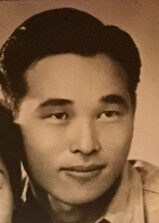
Toshio Kawamoto
Private First Class
100th Infantry Battalion (Separate)
B Company
Toshio Kawamoto was born on December 20, 1918, in San Gabriel, Los Angeles County, California. He was the fourth child of Yaemon and Tome (Okamura) Kawamoto, who emigrated from Yamaguchi Prefecture, Japan. His siblings were: brothers Tokiyoshi (born in Japan) and Matsuji and sister Yoshiko, born in California.
Yaemon (born May 22, 1881) arrived in Honolulu, Territory of Hawaii, on October 17, 1904, on the S.S. Doric. He later returned to Japan and married Tome Okumura (born September 11, 1895), before returning to the US, arriving in Honolulu on November 21, 1913, and going on to San Francisco, California, arriving on November 28, 1913, on the S.S. Nile. On July 25, 1914, Tome arrived on the S.S. Mongolia in San Francisco to join her husband, Yaemon.
On September 12, 1918, when Yaemon signed his World War I draft registration card, the family was living in San Gabriel, and Yaemon was a farmer. In 1920, the family (without Tokiyoshi, who was in Japan) was living on San Bernadino Boulevard in San Gabriel. Yaemon and Tome were truck farmers.
Toshio was taken by his parents to Japan as a young child, returning at the age of five on the Shinyo Maru on February 5, 1923. On September 20, 1924, the family left again for Japan on the S.S. President Hayes and remained. In 1935, daughter Yoshiko was sent from Japan by her parents to live with her uncle, Tokuhei Ota, in Waialua, Oahu, arriving on April 7, 1935, on the Taiyo Maru.
On October 2, 1937, Toshio arrived in Honolulu on the Chichibu Maru from Kobe, Japan. He was an 18-year-old student, sent by his father Yaemon, whose residence was 3862 Kukamachi, Oshima District, Yamaguchi Prefecture. His destination was the home of his sister Yoshiko, who was then living at 2224 Citron Street in Honolulu.
In April 1940, Toshio was residing at the Kawasaki Hotel, a boarding house at 285 North Kukui Street. He was among the 36 boarders living there. His age was 21 and he was employed as a carpenter for a building constructor.
Kawamoto registered for the draft on October 26, 1940, at Local Board No. 3 in Honolulu. His point of contact was a friend, Masayoshi Kayano, who lived at 839 Wiliwili Street. He was 5’3” tall and weighed 125 pounds. On his draft card his employer was listed as Shigeo Shikada of 116 Paoakalani Street near Kalakaua Avenue; however, this information was crossed out.
On November 11, 1941, Kawamoto was listed in the newspaper as being among 111 men in Class A from Local Draft Board No. 3 in Waikiki who were called for induction on Saturday, November 15.
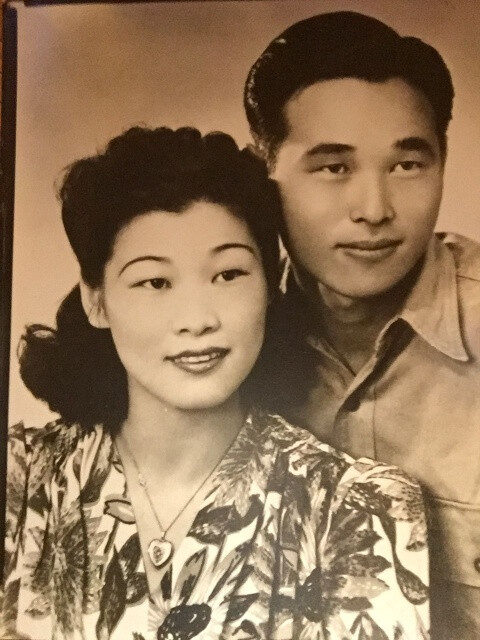
Toshio entered the U.S. Army in Honolulu on November 15, 1941. His civilian occupation was listed as carpenter and he had completed grammar school. He was sent to Schofield Barracks for basic training. Afterwards, he served in the 298th Infantry Regiment, Hawaii National Guard.
Toshio and his sister Yoshiko Kawamoto, 1941/42
Following the attack on Pearl Harbor, Kawamoto was assigned to the Provisional Infantry Battalion of Nisei soldiers. On June 5, 1942, the soldiers were sent to Oakland, California, on the USAT Maui. Upon arrival, their unit was given the name 100th Infantry Battalion and sent to Camp McCoy, Wisconsin, on three separate trains taking different routes. After arriving at Camp McCoy, the unit was redesignated the 100th Infantry Battalion (Separate). Pfc. Toshio Kawamoto was assigned to B Company, Third Platoon. His nickname was Mongoose.
below: Taken “along the rails on the Mississippi River,” June 12-15, 1942, enroute to Camp McCoy.
L to R: Toshio Kawamoto, James Komatsu, Isao Nadamoto, and Fred Kanemura. [Courtesy of Jan Nadamoto]
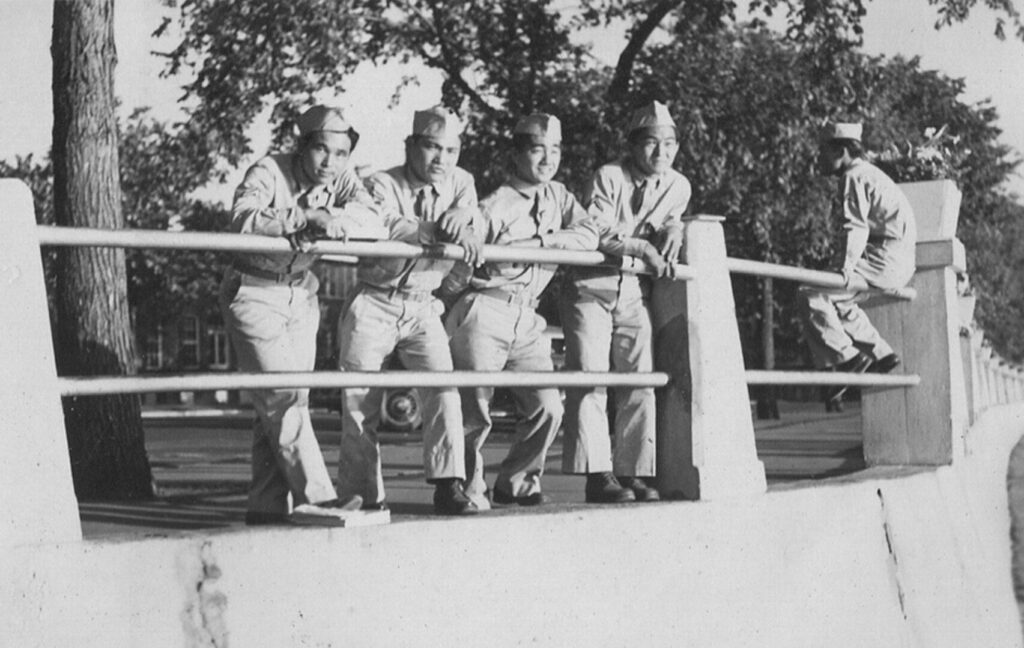
During their time at Camp McCoy, the men were often given day passes to enjoy the sights in the nearby towns of Sparta and LaCrosse.
below: Taken June 21, 1942, at Grandad Bluff above the Mississippi River, near LaCrosse.
Back row, L to R: Tokuji Ono, James Kapelas (who took the men there), Toshio Kawamoto. Front row, L to R: James Komatsu, Isao Nadamoto, Fred Kanemura. [Courtesy of Jan Nadamato]
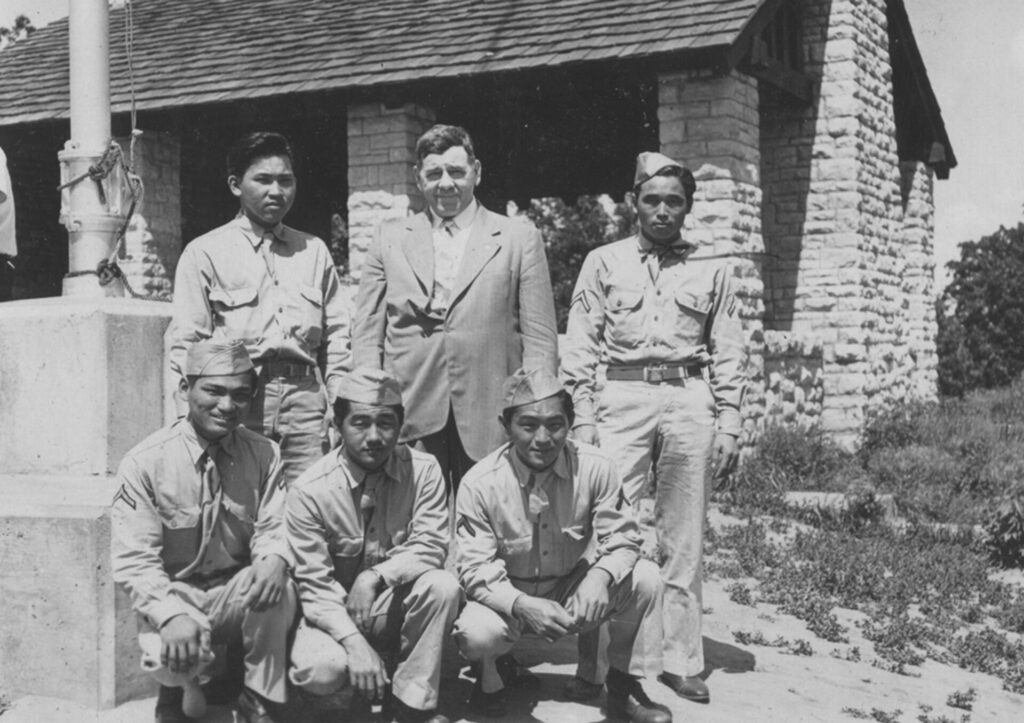
below: L to R: James Komatsu, Richard Oguro, Thomas K. Tsubota (known as Kewpie), Isao Nadamoto, Yukio Takehara, Yutaka Kawamoto, and Toshio Kawamoto, July 4, 1942, on a visit to town. [Courtesy of Jan Nadamoto]
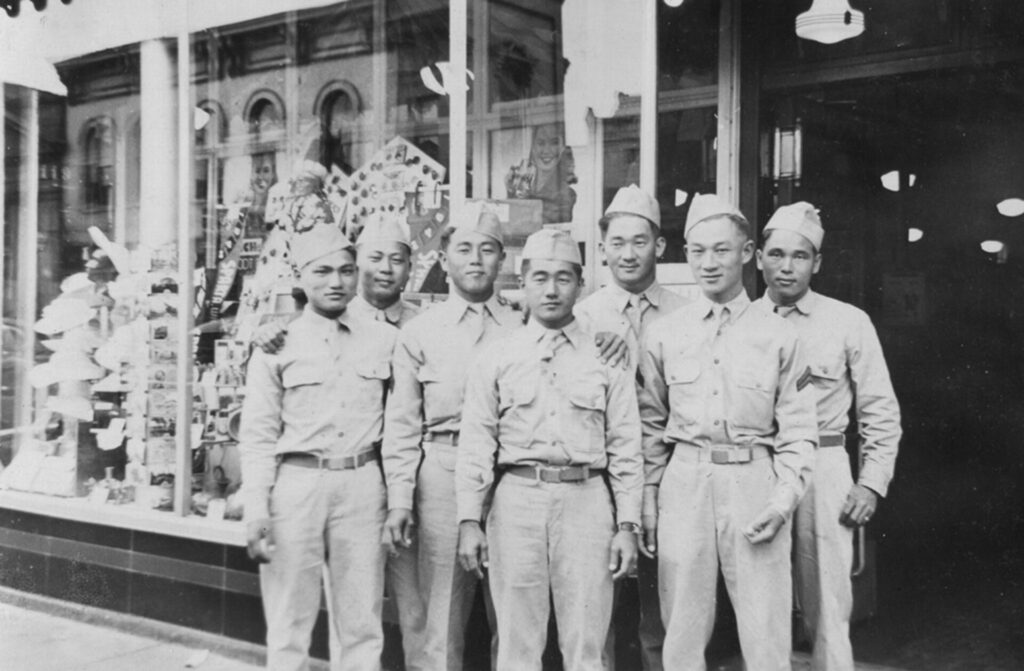
After six months of training, the 100th left Camp McCoy on January 6, 1943, for more combat training at Camp Shelby, Mississippi, the second-largest training camp in the U.S. Army. From April 6 they participated in field exercises, including D Series maneuvers, at Camp Claiborne, Louisiana. On June 9, they returned to Camp Shelby.
In June 1943, many of the men, including Toshio, were given leave and visited cities such as New Orleans, Chicago, New York, or Washington, DC. Toshio and some of his friends went to Washington and saw the U.S. Capitol.
The battalion departed Camp Shelby on August 11, 1943, by train and reached Camp Kilmer, New Jersey, two days later. On August 21, the unit moved by train to Brooklyn, ferried over to Staten Island, and boarded the S.S. James Parker, a troop ship recently converted from a banana and tourist ship. They sailed in a convoy the next day at dusk. On September 2, the battalion landed at Oran in North Africa and was assigned to the 34th (“Red Bull”) Division.
On September 19, 1943, the 100th boarded the landing craft Frederick Funston and arrived offshore of Salerno, Italy, at 8:00 a.m. on September 22. The unit entered combat in the Naples-Foggia Campaign on September 29, near Salerno. During the early days of the campaign, Pfc. Kawamoto was wounded. He was sent to the aid station and/or field hospital, recovered, and returned to duty. On December 25, 1943, notice of his wounding was published in the Honolulu Star-Bulletin, listing his family as sister Miss Yoshiko Kawamoto of 2550 Kalakaua Avenue.
On January 9, 1944, Private First Class Toshio Kawamoto was killed in action near San Vittore del Lazio, Italy, in the Naples-Foggia Campaign. He was buried in the U.S. Military Cemetery at Marzanello Nuovo. His death was announced in the Honolulu Star-Bulletin on February 12.
For his military service, Private First Class Toshio Kawamoto was awarded the Bronze Star Medal, Purple Heart Medal with oak leaf cluster, Good Conduct Medal, American Campaign Medal, Asiatic-Pacific Campaign Medal, European-African-Middle Eastern Campaign Medal with one bronze star, World War II Victory Medal, and Combat Infantryman Badge. He was posthumously awarded the Congressional Gold Medal on October 5, 2010, along with the other men of the 100th/442nd Regimental Combat Team. This is the highest Congressional Civilian Medal.
On December 9, 1945, Pfc. Kawamoto was among 226 soldiers of the 100th Infantry Battalion (Separate) and the 442nd Regimental Combat Team who died during the war and were memorialized at a program held at 1:30 p.m. in the McKinley High School auditorium. The speaker was Lieutenant General Robert C. Richardson, Jr. The service was organized by the 100th Battalion Veterans Club, 442nd Veterans Club, Women’s War Service Association, and the Emergency Service Committee.
In 1948, the U.S. began a program of closing down most of the numerous wartime overseas military cemeteries and consolidating the burials into several large cemeteries or sending the soldier’s remains back home, according to the family’s wishes.
Pfc. Kawamoto’s remains were sent to Hawaii. He and 79 other fallen comrades arrived from San Francisco on October 18, 1948, on the USAT Sgt. Truman Kimbro at 4:15 p.m. at Pier 40. Most of the war dead came from Carano and Marzanello cemeteries in Italy. A dockside service was held and hundreds of family and friends attended. Chaplain Hiro Higuchi of the 442nd RCT participated along with Army Chaplain Edwin L. Kirtley and Navy Chaplain Joseph C. Canty. Territorial Secretary Oren E. Long eulogized the men, saying that Hawaii was proud to have had such sons “who stood the test and added a new chapter to the history of American heroism.” The 264th Army Band played three hymns. Kawamoto’s remains were taken to the Army mausoleum at Schofield Barracks to await burial arrangements. His next of kin was his sister, Yoshiko Hazel Kawamoto Mitchell (who had married James William Mitchell in 1945) of 137 Kaelepulu Street in Lanikai on the Windward side of Oahu.
Toshio Kawamoto was among twenty war dead buried on August 3, 1949, in the National Memorial Cemetery of the Pacific at Punchbowl. His burial was held along with several others at 9:30 a.m. in Section D, Site 132.
Researched and written by the Sons & Daughters of the 442nd Regimental Combat Team in 2025. Photos courtesy of Jan Nadamoto.